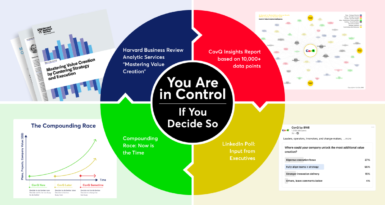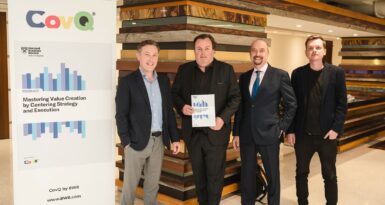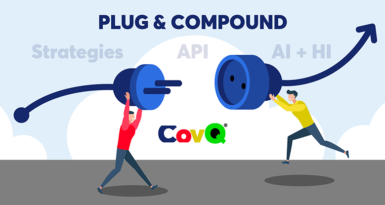
We took a four-step approach to explore where companies can unlock the most additional value creation and what it takes to actually deliver on that potential.

This report aggregates insights from more than 10,000 data points from CovQ® Assessments conducted across industries to understand how companies perform in delivering mission, accelerating growth, fostering innovation, and driving productivity. CovQ®—the Compound Value Creator Quotient—is the augmented intelligence of a new category of Value Creation Management Platforms (HBR Analytic Services Report “Mastering Value Creation”). It enables organizations to align strategy and execution through value-driver-based prioritization, monitoring, and collaboration. CovQ® Scores and CovQ® Factors or Team Alignment range from 10 (insufficient) to 100 (outstanding). This CovQ® Insights Report—developed from proprietary data, artificial intelligence, and human insight—delivers deployable, time-sensitive intelligence to fuel strategic execution and outperform in growth, innovation, and productivity and to become a Compounding Leader.

We are excited to share some impressions of our exclusive launch event celebrating the Special Report, “Mastering Value Creation by Centering Strategy and Execution,” produced by HBR Analytic Services (Harvard Business Review) in association with CovQ by 8W8. The event was hosted at Grant Thornton in New York City. We would like to thank Markus Veith, Partner at Grant Thornton in charge of the Northeast Financial Institutions Practice, for facilitating the event, and Alex Clemente, Managing Director of HBR Analytic Services, for presenting the findings and moderating the panel with accomplished business leaders Alasdair Trotter, National Managing Principal and Head of Growth Advisory at Grant Thornton, Stas Chijik, CEO of CovQ client Billfold, and Ralf Hirt, CEO of CovQ by 8W8.

The Reinvention Summit is more than an event—it’s a call to action for leaders navigating today’s rapidly evolving business landscape.

From Strategy to Execution—Seamlessly and Inevitably Every company has strategies. But let’s face it—strategies alone don’t create value. Execution does. The ability to translate strategy into compounding results is the defining factor between winners and those left behind. That’s where CovQ introduces Plug & Compound—the fastest way to turn strategy into impact, outcomes and results. Clients can start step by step or go all in.

In the rapidly evolving business management landscape, the intersection of Artificial Intelligence (AI) and Human Intelligence (HI) has created unprecedented opportunities to supercharge organizational performance and shareholder value creation. At the heart of this synergy lies the AI-agnostic CovQ (Compound Value Creator Quotient) value creation management platform, which the Harvard Business Review Analytic Services* introduced as a new category of enterprise software solutions.

AI is riding the hype cycle at full speed. Everywhere you turn, companies, executives, and consultants are asking, “What’s your AI strategy?” It sounds almost as if AI were an end in itself—a standalone function operating in isolation, disconnected from core business priorities. The result? A deep dive into AI rabbit holes, where tactical improvements deliver small wins but never move the needle in a meaningful way.

We are thrilled to announce that CovQ® by 8W8 is now a Member of the SAP® PartnerEdge® open ecosystem. This grants CovQ® access to critical SAP® resources, including essential sales and marketing support, education, training, enablement, service benefits, and development tools.

In today’s fast-paced market, speed is a competitive advantage that directly influences a company’s market cap and overall valuation. But it’s not just about realizing value quickly—it’s about how that value compounds over time. Time to Value (TTV) is the key metric that determines how fast businesses capture and build on that value. The faster they can accelerate TTV, the more your results compound, creating a snowball effect on market cap, valuation, and long-term growth.